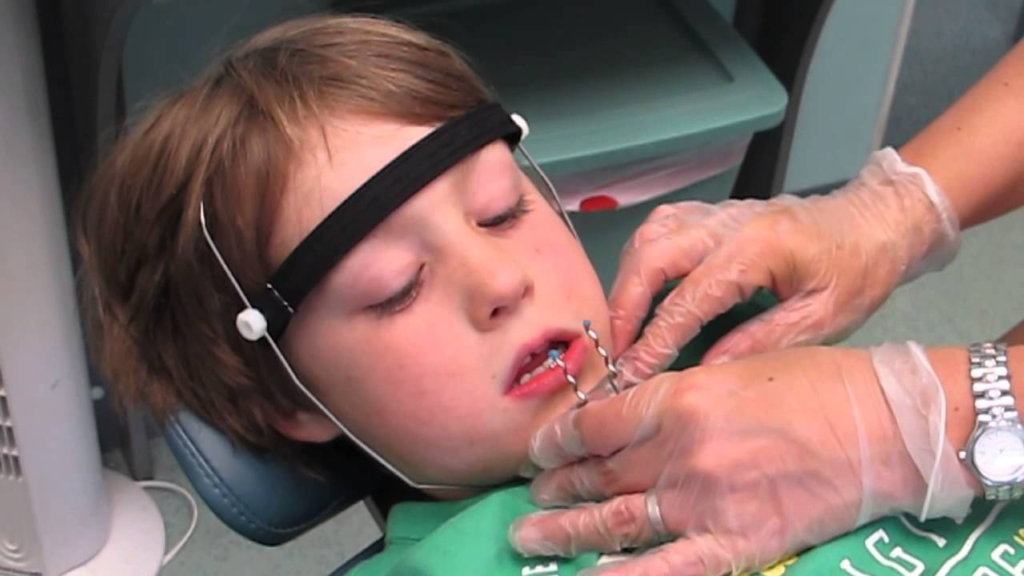
If your orthodontist has recommended protraction headgear, you might have some questions about what it is, why you need it, and how to wear it properly. This guide will help you understand everything you need to know about protraction headgear and how to get the best results from your treatment.
What is Protraction Headgear?
Protraction headgear, also known as a reverse headgear or facemask, is an orthodontic device designed to pull the upper jaw forward. It is commonly used for patients whose top front teeth bite behind the bottom front teeth (a condition called an underbite).
How it works:
- It has a chin support and a forehead support, connected by a metal frame.
- The metal frame is attached by elastics to either a removable or fixed brace on your upper teeth.
- Sometimes, it is used with a brace to widen the top jaw.
Why Do I Need Protraction Headgear?
Your orthodontist has recommended protraction headgear to:
- Move your upper jaw and teeth forward
- Correct your bite so that your top teeth sit in front of your bottom teeth
- Create space for proper alignment of your teeth in future treatments
By wearing your headgear as instructed, you can prevent more complex dental issues later in life and improve your smile.

How Long Will I Have to Wear Protraction Headgear?
For the best results, you should wear your headgear for about 14 hours a day (usually overnight and some additional time during the day).
Average Treatment Duration:
- Treatment typically lasts between 6 to 18 months.
- The more consistently you wear it, the quicker your treatment will be.
Will I Need Another Brace After This?
Yes, in most cases, further orthodontic treatment will be needed after using protraction headgear.
Once your jaw position is corrected, you will likely need braces when you’re older to straighten your teeth and ensure they stay in the right position.

Is Protraction Headgear Painful?
It is normal to feel some discomfort when you first start wearing the headgear.
What to Expect:
- Your teeth may be sore for 3-5 days after fitting.
- You may feel pressure on your chin and forehead, but this should only last a few days.
- If necessary, you can take mild painkillers (such as the ones you use for a headache)—always follow the instructions on the packet.
- If the headgear rubs against your skin, tell your orthodontist so adjustments can be made.
Important Safety Instructions
To keep your treatment on track and avoid injury, follow these safety guidelines carefully:
How to wear and remove the headgear properly:
- Always remove the elastics before taking off the metal frame.
- Your orthodontist will show you how to put it on and take it off safely—follow their instructions carefully.
Avoid wearing it during:
- Contact sports
- Rough play or activities that might cause it to come loose
Daily Maintenance:
- Change the elastics every day to keep them effective.
- Bring your headgear to every orthodontic appointment so your orthodontist can check for any issues.
If your headgear comes off during sleep:
- Stop wearing it immediately and call your orthodontist for an appointment as soon as possible.
- Do not wait for your next routine check-up—a broken or improperly fitted headgear could delay your treatment.

Taking Care of Your Teeth and Protraction Headgear
Now that you understand how protraction headgear works and how to wear it safely, it’s important to know how to maintain good oral hygiene, attend regular check-ups, and handle any issues that may arise.
Brushing Your Teeth While Wearing Protraction Headgear
Good oral hygiene is essential during your treatment. Wearing orthodontic appliances makes it easier for plaque and food particles to get trapped, so proper brushing is more important than ever.
How to keep your teeth clean:
- Remove your headgear before brushing to clean all areas of your teeth properly.
- Brush for at least 2 minutes, twice a day using a fluoride toothpaste.
- If possible, carry a toothbrush with you for an additional clean after lunch.
- Use an alcohol-free fluoride mouthwash daily (but at a different time from brushing) to strengthen your teeth.
- Do not eat or rinse for at least 20 minutes after using mouthwash to allow it to work effectively.
Warning: Poor cleaning habits and consuming too many sugary snacks or drinks can cause permanent damage to your teeth, including cavities and white or brown stains.
Can I Eat While Wearing My Headgear?
No. You must remove your protraction headgear before eating and drinking.
- Wearing your headgear while eating could damage the appliance and make eating difficult.
- Always store your headgear safely during meal times to avoid misplacing or damaging it.
How Often Will I Need an Appointment?
You will need regular orthodontic check-ups approximately every 6-8 weeks.
- These visits help your orthodontist monitor your progress and make any necessary adjustments.
- Always bring your headgear with you to every appointment so your orthodontist can check that it is working properly.
Do I Still Need to See My Regular Dentist?
Yes! You should continue to visit your regular dentist for routine check-ups throughout your orthodontic treatment.
Your dentist will check for:
- Cavities or early signs of tooth decay
- Gum health
- Any other dental concerns that may affect your treatment
Regular dental visits will ensure your teeth stay healthy while your orthodontic treatment progresses.
What Should I Do If There Is a Problem With My Headgear?
If your protraction headgear becomes loose, breaks, or comes off during sleep, contact your orthodontist as soon as possible.
Do NOT wait for your next scheduled appointment.
- Delays in fixing your headgear could slow down your treatment and even cause damage to your teeth.
Call your orthodontist immediately if you experience:
- A broken or loose headgear frame
- Discomfort that doesn’t go away after a few days
- Difficulty putting on or removing the headgear
- Any other concerns related to the appliance
Final Reminders for Successful Treatment
- The more you wear your protraction headgear, the faster your treatment will be!
- Follow your orthodontist’s instructions for safely putting on and removing the headgear.
- Contact your orthodontist immediately if your headgear breaks or comes off at night.
- Brush your teeth for at least 2 minutes, twice a day using fluoride toothpaste.
- Bring your headgear to every orthodontic appointment to ensure it is working correctly.
By following these guidelines, you will get the best possible results from your treatment and move one step closer to a healthier, straighter smile!
If you have any questions, don’t hesitate to ask your orthodontist for advice.



